Here’s the perfect way to use those juicy, ripe, end-of-summer tomatoes – Fresh Tomato and Basil sauce for pasta, meatballs, pizza and flatbreads, and more! Using a little tomato paste enhances the flavor and texture, while grating the tomatoes is an easy way to simultaneously remove the skins and crush them – no need for blanching. Garlic flavor is subtly infused throughout, with fresh basil leaves and some (optional) butter added at the end for a wonderfully simple, rich, from-scratch tomato sauce made with fresh tomatoes.
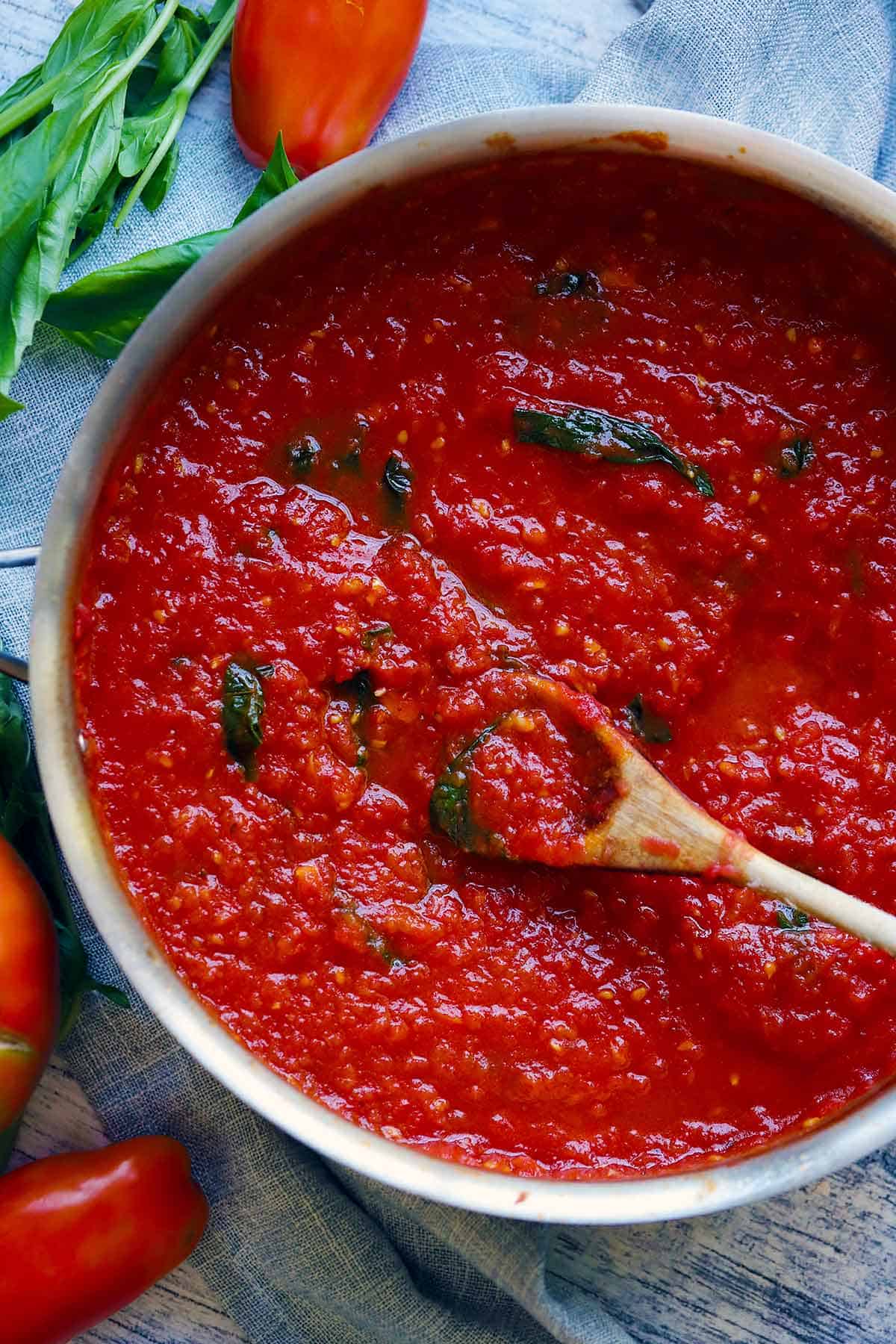
I realize I’m “supposed” to be posting apple and pumpkin recipes since it’s “September” and I’m a “food blogger” but alas, the weather and my garden disagrees. It’s 90 degrees and wicked humid and I have a huge pile of ripe tomatoes beckoning to fulfill their delicious destiny. So here’s one more summer recipe to close out the season!
I’ve been on the search for a great from-scratch tomato sauce for pasta made with fresh tomatoes. Regular tomatoes – heirloom, slicing, etc. – not specifically San Marzano. This fresh tomato sauce is a wonderful solution for using any medium to large tomato. In fact, I think it’s better than Rao’s *gasp!* and my husband wholeheartedly agreed. I know you’ll love it, too!
You’ll need to do a bit of prep work for this. First, you’ll scoop as many seeds as possible out (which can add a bitter taste to the sauce). Then, you’ll grate the inside of the tomatoes to crush them into a pulp and separate them from the skin. Once you’ve done that, this sauce comes together in mere minutes!
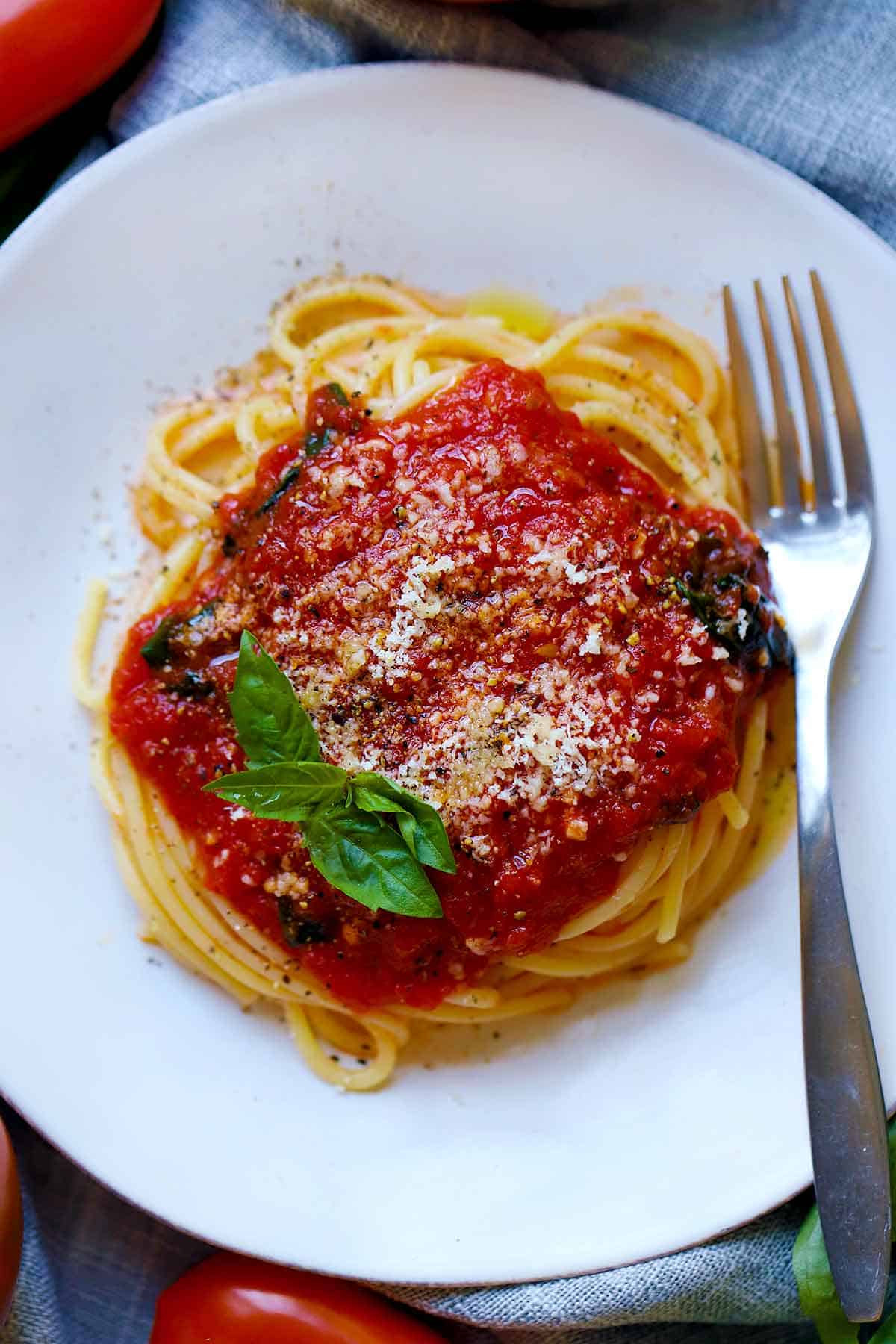
What kind of tomatoes can I use?
You can use any kind of medium – large tomato for this recipe. I used what I had from my garden – a combination of brandywine heirloom tomatoes and celebrity slicing tomatoes.
San Marzano (aka Roma or Plum tomatoes) are usually used for from-scratch tomato sauce recipes. They aren’t necessary here (though you can use them if you want!). They’re prized for not having a lot of seeds and for being particularly “meaty” – perfect for sauce.
But for this recipe, you can stick with whatever tomatoes you have. The only ones that won’t work are small tomatoes, such as cherry or grape tomatoes. It would be too difficult to remove their skins and seeds.
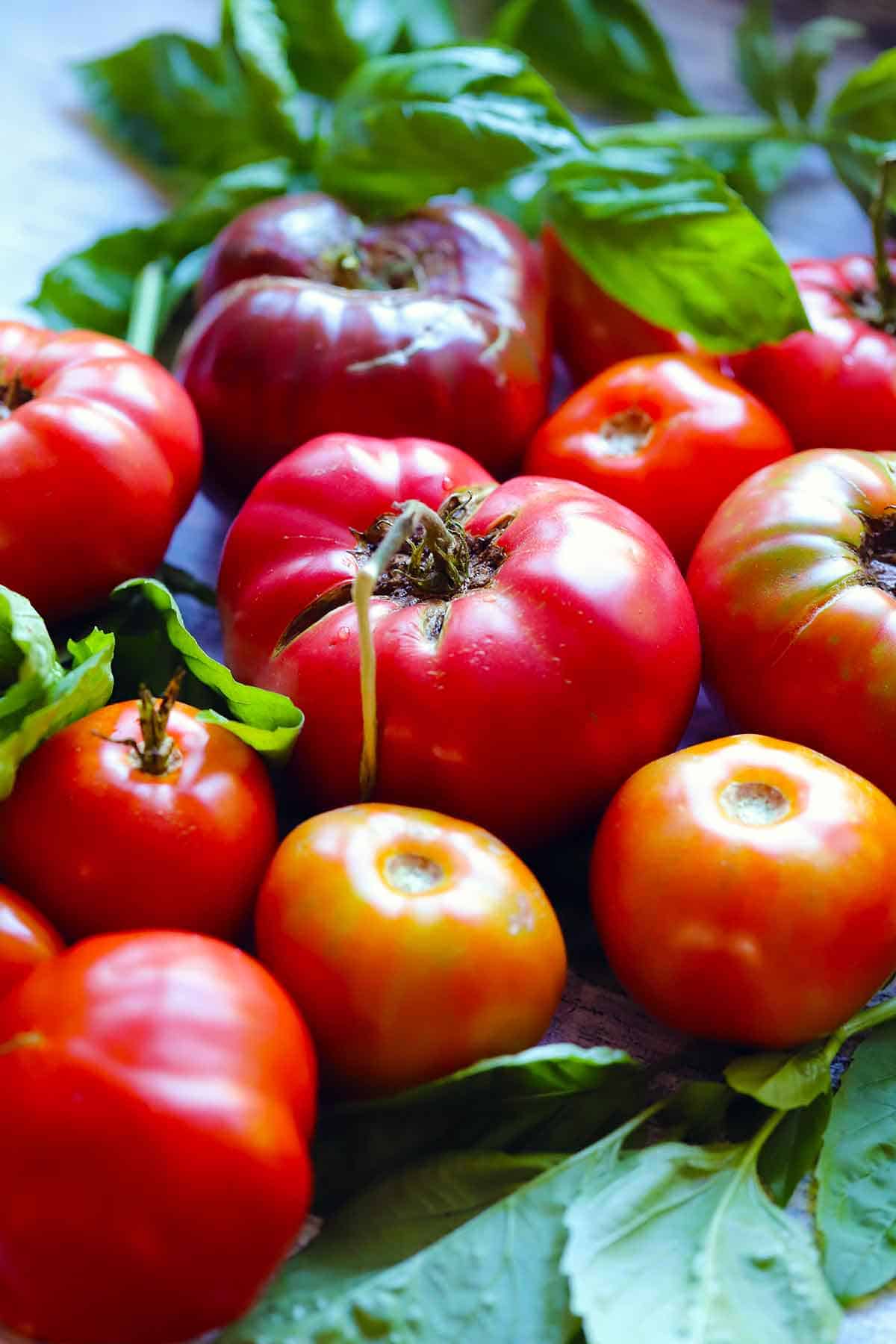
Ingredients for Fresh Tomato Sauce
- Fresh Tomatoes – any kind of medium to large fresh tomato (cherry or grape tomatoes won’t work).
- Olive oil
- Garlic cloves
- Tomato Paste
- Fresh Basil
- Salt
- Butter – optional, but HIGHLY RECOMMENDED!
- Crushed red pepper – again, optional, but adds a subtle kick that is oh-so-delicious and not overwhelming! You can also use Aleppo pepper or Calabrian chili paste or other spicy addition of choice.
How to make tomato sauce from scratch using fresh tomatoes
First, you’ll need to prep the tomatoes. Cut them in half lengthwise, squeeze the seeds out using a spoon to help you remove them, and grate with a box grater. You’ll be left with a tomato pulp, and you can discard the seeds and skins. Don’t worry if there are a few seeds left! Then, place the pulp in a mesh sieve placed over a bowl to catch the liquid. You want the liquid to drain away from the pulp as much as possible, otherwise the sauce will take longer to cook and reduce.


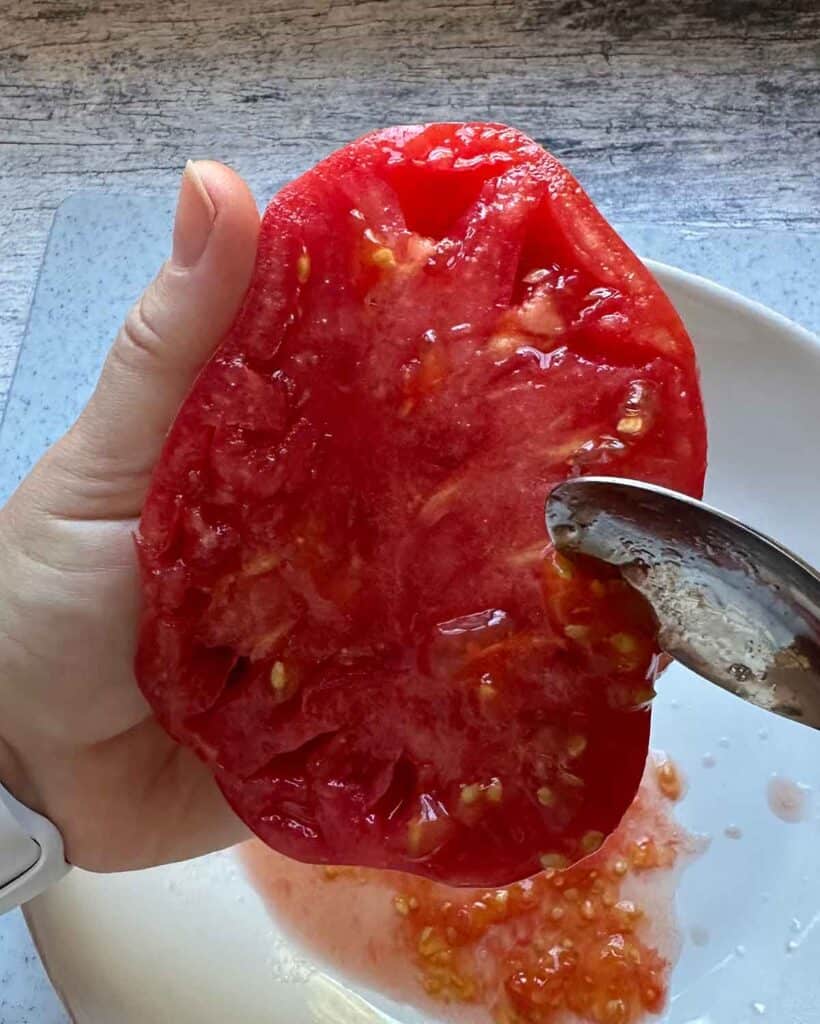

And while we prep the tomatoes, we’re going to let a couple of smashed garlic cloves and a little red pepper (if you want it to have a little kick) cook over low heat in olive oil, infusing the oil with the perfect amount of subtle garlic flavor that will reach every part of the sauce. After about 3-5 minutes, remove the garlic cloves to a cutting board, allow them to cool, and chop them up finely.
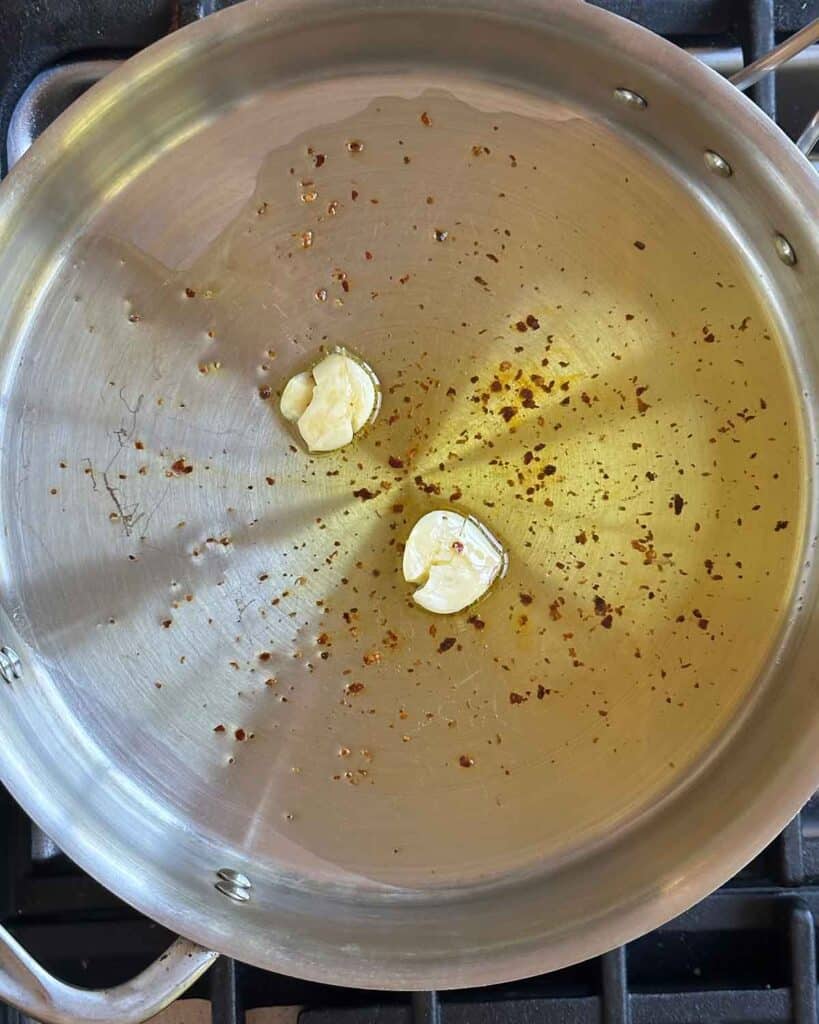

Add some tomato paste to the garlicky oil and heat for at least two minutes, stirring it around to break it up and incorporating it into the oil.


Stir in the tomato pulp to the skillet. To avoid splattering, I like to add one ladle full of the pulp, stir it, then add the rest, as well as the chopped garlic from before. Simmer that for at least 5-10 minutes, but preferably longer to develop flavor and allow the sauce to reduce and thicken.
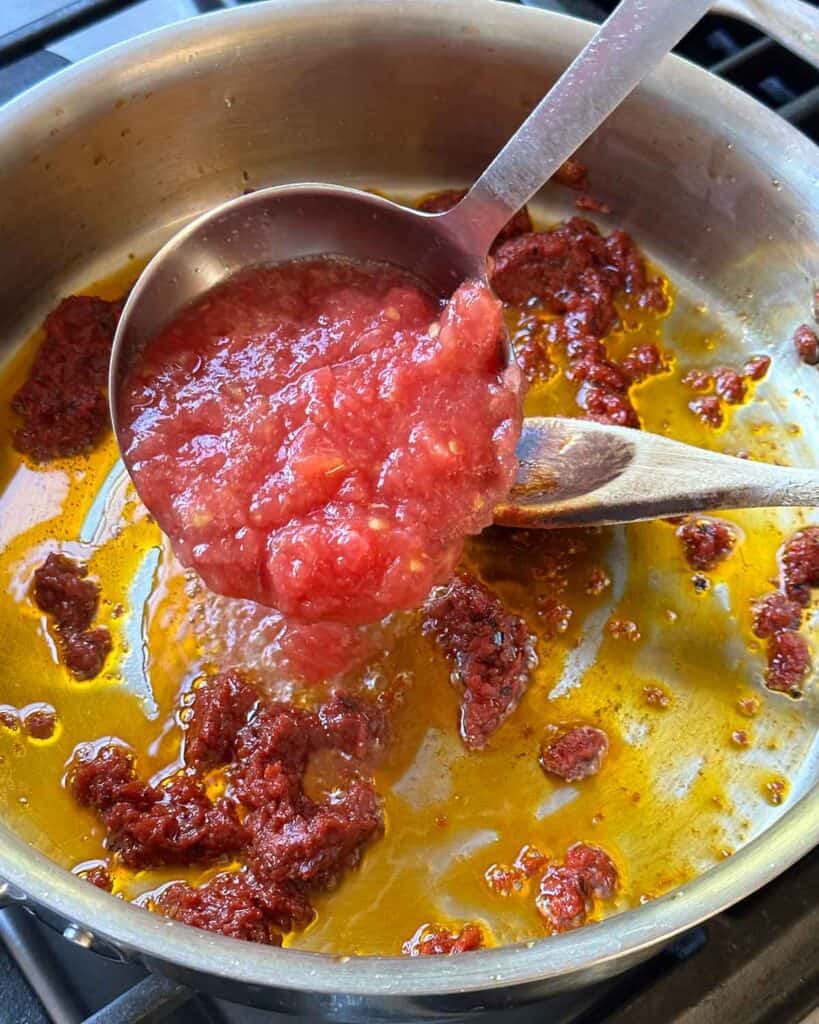
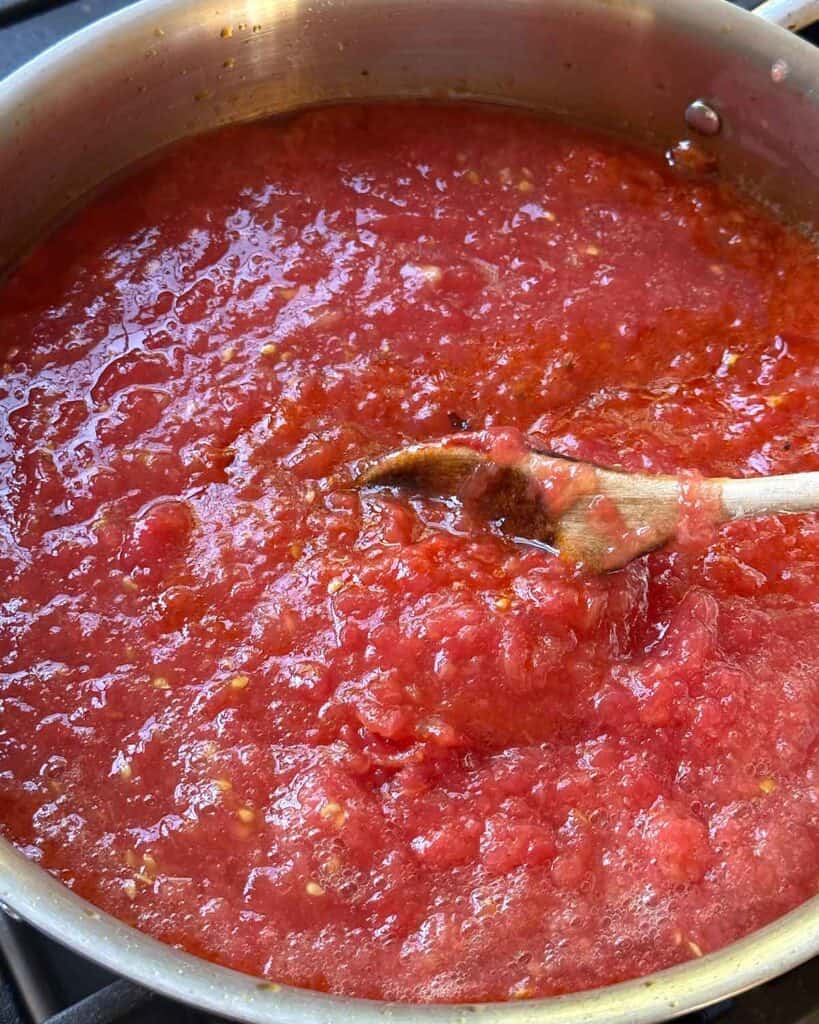
Finally, once the sauce has reduced and thickened to a desirable consistency, turn off the heat. Then, stir in the fresh basil leaves and some butter until the leaves wilt and the butter melts. Serve, or store for later!
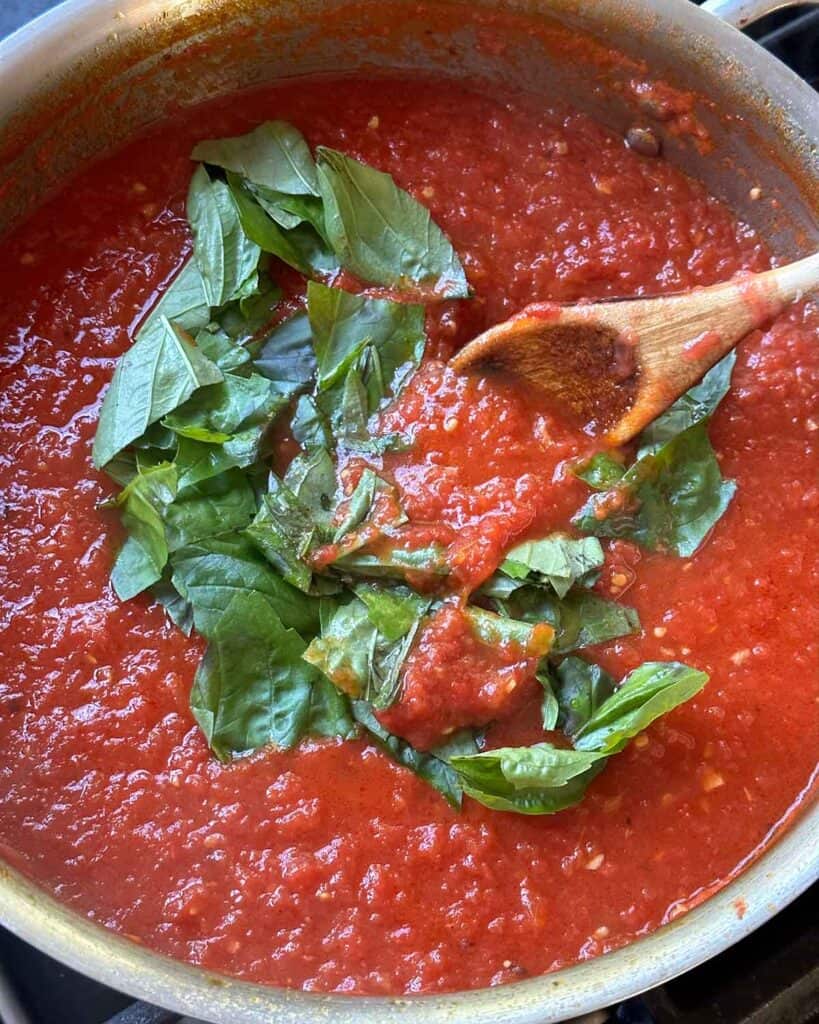

How to store homemade tomato sauce
You can store homemade fresh tomato sauce in an airtight container in the refrigerator for about a week, or in the freezer for about six months for best results.
Can I use canned tomatoes?
This sauce recipe calls for fresh tomatoes, but here’s my favorite marinara sauce made with canned crushed tomatoes! It’s a bit easier, if you want something with less prep.
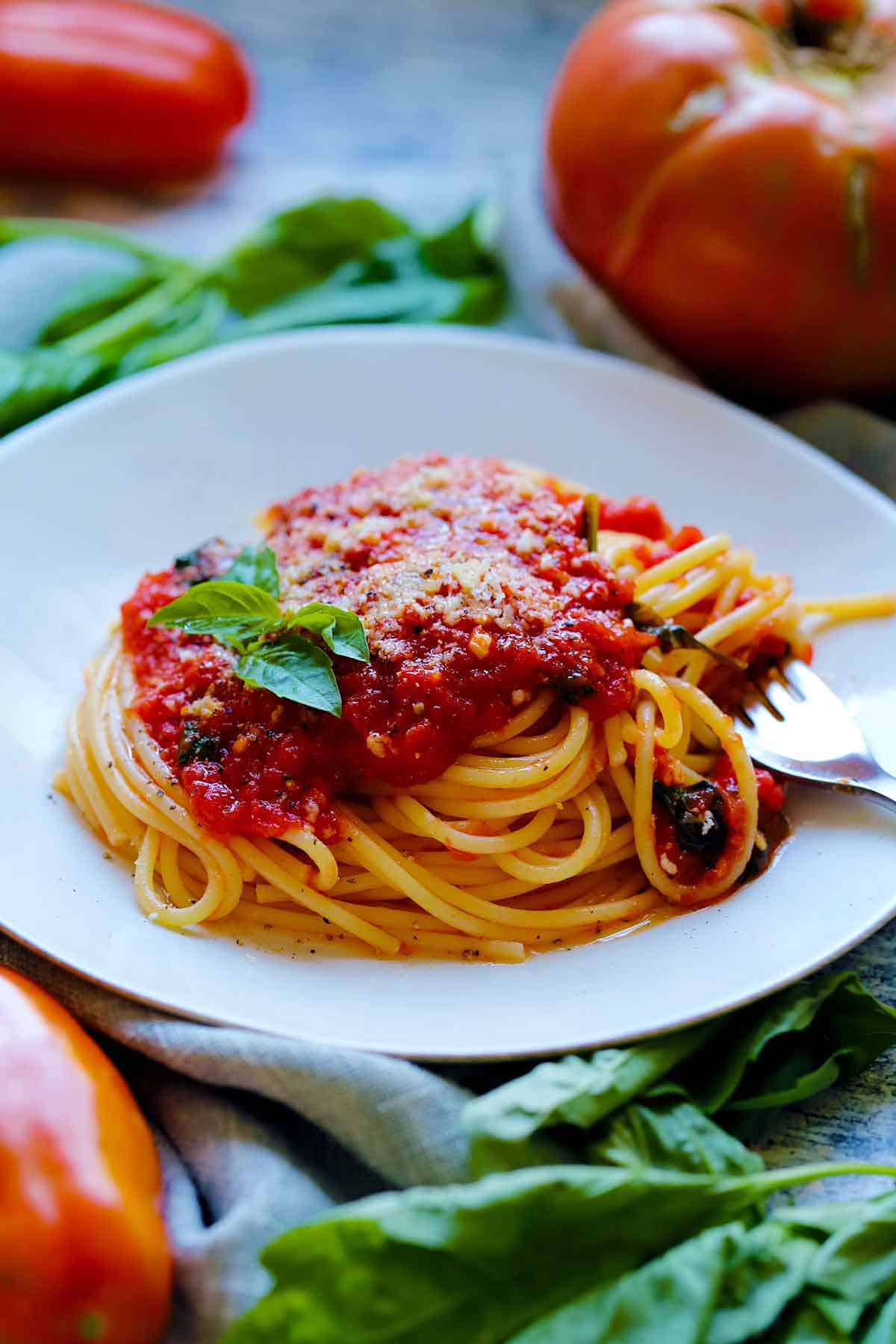
Recipes in which to use fresh tomato sauce
Here are some recipes that call for jarred marinara sauce, but this homemade tomato sauce can just as readily be used!
- Baked Gnocchi
- Easy Eggplant Parmesan
- One-Pot Spaghetti with Meat Sauce
- Chicken Parmesan Sliders
- As a dip for Toasted Ravioli
Did you know commenting and rating recipes is one of the best ways you can support your favorite food bloggers? If you made this recipe or have a question, please click the stars below to comment and Rate this Recipe and/or share photos on social media using the hashtag #bowlofdelicious or tagging @bowlofdelicious!

Fresh Tomato Sauce with Basil and Garlic
Equipment
- deep skillet or pot
- box grater
Ingredients
- 4-5 lbs. tomatoes medium – large in size, not cherry or grape tomatoes.
- ¼ cup extra-virgin olive oil
- 2 cloves garlic smashed
- ½ teaspoon crushed red pepper or Aleppo pepper, optional, more or less depending on spice preference.
- 2 tablespoons tomato paste
- 1 teaspoon kosher salt
- ½ cup torn fresh basil leaves
- 1 tablespoon butter optional, but HIGHLY RECOMMENDED
Instructions
- Prepare the tomatoes: Slice the 4-5 lbs. tomatoes in half cross-wise (separating the top from the bottom). Squeeze the seeds out, using a spoon to help you scrape them off the surface of the cut-side of the tomato into a bowl or container.
- Set a box grater over a shallow bowl and grate the inside of the tomato, separating the flesh from the skin. Discard both the seeds and the skin. Place the tomato pulp into a mesh sieve set over a bowl and allow the liquid to drain. Set aside.
- Heat the ¼ cup extra-virgin olive oil in a large deep skillet over low heat. Add the smashed 2 cloves garlic and the ½ teaspoon crushed red pepper, if using. Allow to cook for 3-5 minutes, until the garlic is fragrant and has infused the oil, but not too browned or burned. Remove the garlic cloves with tongs and set aside. Once it's cooled, chop it up finely.
- Add the 2 tablespoons tomato paste. Stir into the oil, continuing to cook on low for approximately 2 minutes.
- Add the tomato pulp into the skillet (I like to start with a ladle of the pulp at first, to prevent too much splattering, then add the rest), and discard the liquid that has drained into bottom of the bowl. Add the 1 teaspoon kosher salt, as well as the chopped garlic from before. Stir together and allow to simmer, uncovered, for at least 5-10 minutes (or until much of whatever liquid remains has evaporated – see notes).
- Turn off the heat and add the ½ cup torn fresh basil leaves. and the 1 tablespoon butter, if using. Stir in until leaves have wilted and butter has melted completely. Serve with cooked pasta, with meatballs, on pizza, or however else you use tomato sauce.
Notes
- The amount of time needed after the tomato pulp is added will depend on a few factors – for example, how much liquid was removed from the tomatoes, how watery they were to begin with, how much time you have available, and your preferences! The longer it simmers, the more concentrated and sweet the flavor will be. Do keep an eye on it, because once the liquid evaporates, the sauce will thicken and may stick to the pot. If this happens, add a little water to loosen it up, and either stop cooking it or add a cover on the pot to continue simmering.
- To add a little sweetness to your sauce, which may be necessary with a brief cooking time or if the tomatoes weren’t completely ripe, you can add a little bit of sugar to the sauce. Alternatively, grated carrots are sometimes added to marinara sauce for sweetness – just give them enough time to cook down in the sauce!
- Store the sauce in your fridge in an airtight container for about a week, or in the freezer for about six months for best results.
Nutrition
Nutrition Information Disclaimer
The provided nutrition information is my best estimate and does not include any added sodium from seasoning to taste, any optional ingredients, and it does not take brands into account. I use an automatic API to calculate this information. Feel free to calculate it yourself using one of these tools:


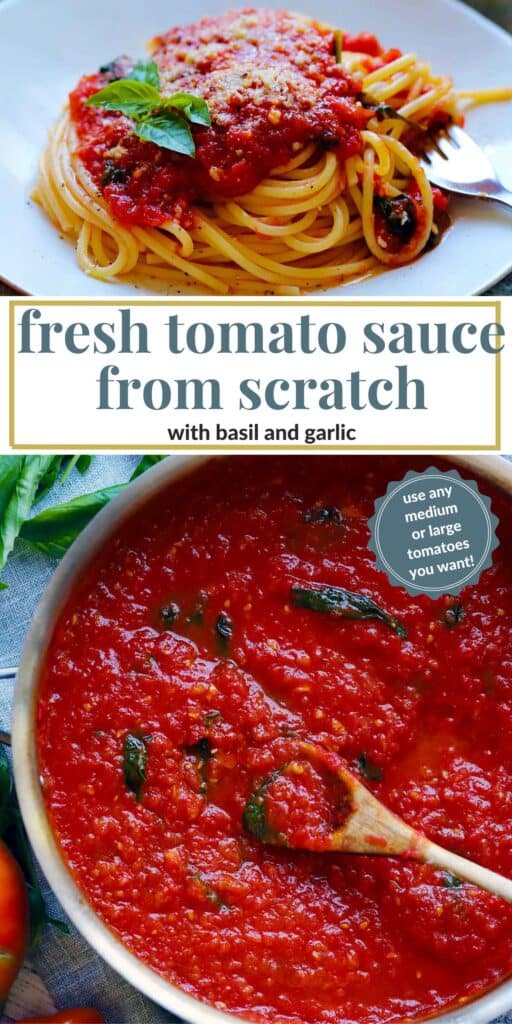

Eileen
Can canned tomatoes be used or pomi ?
Thanks
Elizabeth Lindemann
I haven’t tried it with canned tomatoes or pomi tomatoes yet but I don’t see why not!
Tanya Ann Steers
There’s actually a tool that removes the skin after cooking I’ll let you research
Elizabeth Lindemann
I’ll look into it, thanks!
DianeGhig
Was so delicious. Sometimes, I also add some Half & Half at the end to make it a lower fat cream sauce.
This recipe is a keeper! Tonight I served it over ricotta raviolis.
Elizabeth Lindemann
Glad you liked it! Love the tip about how to make a tomato cream sauce. Thanks for sharing!
Robert P Kulla
Is it possible to pressure can in a Ball/Mason jar directly after completing the above recipe as is.
Elizabeth Lindemann
I can’t provide good advice about canning unfortunately, but I do know there has to be a certain PH level for it to be safe. This might be a good place to start – they recommend adding lemon juice to citric acid to make it acidic enough! https://nchfp.uga.edu/how/can_03/tomato_sauce.html
Hugh O'Connor
You can use ANY tomatoes for this recipe, though I’d avoid black skinned ones. There is really no need to remove the seeds and skins; the skins will breakdown and the garlic and basil will remove any bitterness (if any) from the seeds – blanching the garlic before will sweeten it.
Elizabeth Lindemann
Black skinned tomatoes can be used, and will only add a darker color to the sauce (so yes, avoid them if your goal is a bright red sauce!). As far as leaving skins and seeds in – while this may be a tempting shortcut, and can certainly be done if you want, the skins and seeds do definitely add bitterness and the skins of tomatoes won’t break down enough to result in the silky smooth texture I was looking for in this sauce recipe. While this recipe does call for removing the skins and seeds for texture and flavor reasons, you can certainly make that choice for yourself. Almost all Italian homemade tomato sauce recipes require removing skins from tomatoes. Love the tip about blanching the garlic – I’ve never tried that!
Tony
Box cutter? You mean box grater.
Elizabeth Lindemann
Yes, yes, I did mean box grater! Thanks so much for bringing this to my attention – it’s fixed!